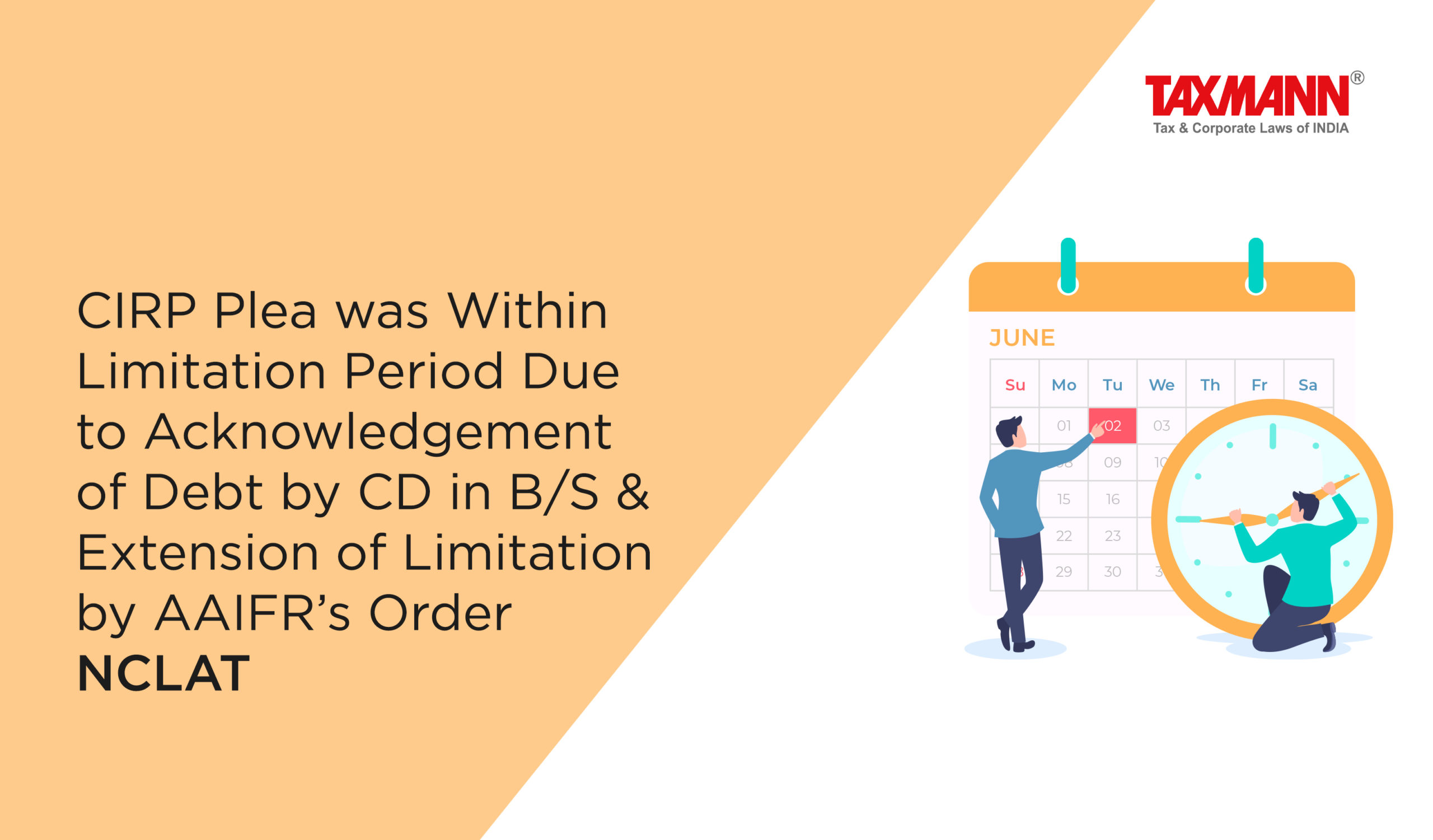CIRP Plea was Within Limitation Period Due to Acknowledgement of Debt by CD in B/S & Extension of Limitation by AAIFR’s Order | NCLAT
- Blog|News|Insolvency and Bankruptcy Code|
- 3 Min Read
- By Taxmann
- |
- Last Updated on 19 September, 2023

Case Details: Asset Reconstruction Company (India) Ltd. v. Uniworth Textiles Ltd. - [2023] 153 taxmann.com 748 (NCLAT-New Delhi)
Judiciary and Counsel Details
-
- Rakesh Kumar Jain, Judicial Member & Naresh Salecha, Technical Member
- Abhiroy Dasgupta & Ishaan Duggal, Advs. for the Appellant.
- N.M. Sharma, Ankur Sood, Ms. Shubhangi Tiwari & Utkarsh Sharma, Advs. for the Respondent.
Facts of the Case
In the instant case, the respondent (i.e., the corporate debtor) had taken loans from the appellant (i.e., the financial creditor) for an amount of Rs. 41.50 crores. However, the corporate debtor defaulted in making the repayment and its account was declared NPA on 31.08.2007.
Thereafter, the appellant issued a notice under section 13(2) of the SARFAESI Act, 2002 on 20-11-2007. The appellant filed an application before the Debt Recovery Tribunal (DRT) u/s 19 of the Recovery of Debt to the Banks and Financial Institution Act, 1993 and the same was allowed by DRT.
Thereafter, the corporate debtor came forward for settlement with the appellant and sent a proposal on 19-9-2016 to clear its dues and, issued a letter acknowledging the debt to the appellant along with the details of the assets which had charge of the appellant for loan. However, the appellant was not getting payment of outstanding dues from the corporate debtor.
Consequently, the appellant filed an application u/s 7 for the due amount on 27-11-2018. The Adjudicating Authority (NCLT) by the impugned order dismissed the said application on the ground of limitation. Thereafter, an appeal was made to the National Company Law Appellate Tribunal (NCLAT) against the order passed by the NCLT.
The appellant alleged that the application filed under section 7 by the financial creditor was within the limitation.
It was submitted that the respondent initiated proceedings before BIFR in the year 2004, which continued till 2013 and were abated by AAIFR vide order dated 22-5-2013. It was further submitted that the balance sheet of the corporate debtor for financial years 2006-07 and 2018-19, had shown acknowledgement of entire dues under the loan agreement by the corporate debtor.
Further, it was submitted that for computing period of limitation, especially where proceedings for enforcement remained pending under SICA was required to be excluded for counting limitation period in terms of section 22(1) of SICA.
NCLAT Held
The NCLAT held that the period of the petition before BIFR and AAIFR, once abated by the competent Judicial Forum, ought to have been excluded by the NCLT. Therefore, NCLT erred in rejecting the application filed under section 7 by the appellant on the grounds of limitation.
List of Cases Reviewed
-
- Order of NCLT (KOLKATA) in CA (IB) No. 1441/KB/2019 in CP (IB) No. 1593/KB/2018, dated 17-3-2020 (para 35) reversed.
- Asset Reconstruction Company (India) Ltd. v. Bishal Jaiswal [2021] 126 taxmann.com 200/166 SCL 82 (SC) (para 32) followed.
List of Cases Referred to
-
- Jignesh Shah v. Union of India [2019] 109 taxmann.com 486/156 SCL 542 (SC) (para 9)
- Gouri Prasad Goenka v. Punjab National Bank [2020] 119 taxmann.com 452/162 SCL 462 (NCLAT) (para 14)
- Mahabir Cold Storage v. CIT [1991] 56 Taxman 4ZF/188 ITR 91 (SC) (para 15)
- A.V. Murthy v. B.S. Nagabasavanna [2002] 2 SCC 642 (para 15)
- Usha Rectifier Corpn. (I.) Ltd. v. CCE [2011] 11 SCC 571 (para 15)
- S. Natarajan v. Sama Dharman [MANU/SC/698/2014] (para 15)
- B.K. Educational Services (P.) Ltd. v. Parag Gupta and Associates [2018] 98 taxmann.com 213/150 SCL 293 (SC) (para 24)
- Innoventive Industries Ltd. v. ICICI Bank Ltd. [2017] 84 taxmann.com 320/143 SCL 625 (SC) (para 24)
- Sagar Sharma v. Phoenix ARC (P.) Ltd. [2019] 110 taxmann.com 50/156 SCL 1707 (SC) (para 24)
- Asset Reconstruction Company (India) Ltd. v. Bishal Jaiswal [2021] 126 taxmann.com 200/166 SCL 82 (SC) (para 26)
- Gautam Sinha v. UV Asset Reconstruction Company Ltd. [2020] 116 taxmann.com 748 (NCLAT) (para 26)
- V. Padmakumar v. Stressed Assets Stabilisation Fund (SASF) [2021] 123 taxmann.com 331 (NCLAT) (para 26)
- Sabarmati Gas Ltd. v. Shah Alloys Ltd. [2023] 146 taxmann.com 90/176 SCL 136 (SC) (para 32).
Disclaimer: The content/information published on the website is only for general information of the user and shall not be construed as legal advice. While the Taxmann has exercised reasonable efforts to ensure the veracity of information/content published, Taxmann shall be under no liability in any manner whatsoever for incorrect information, if any.

Taxmann Publications has a dedicated in-house Research & Editorial Team. This team consists of a team of Chartered Accountants, Company Secretaries, and Lawyers. This team works under the guidance and supervision of editor-in-chief Mr Rakesh Bhargava.
The Research and Editorial Team is responsible for developing reliable and accurate content for the readers. The team follows the six-sigma approach to achieve the benchmark of zero error in its publications and research platforms. The team ensures that the following publication guidelines are thoroughly followed while developing the content:
- The statutory material is obtained only from the authorized and reliable sources
- All the latest developments in the judicial and legislative fields are covered
- Prepare the analytical write-ups on current, controversial, and important issues to help the readers to understand the concept and its implications
- Every content published by Taxmann is complete, accurate and lucid
- All evidence-based statements are supported with proper reference to Section, Circular No., Notification No. or citations
- The golden rules of grammar, style and consistency are thoroughly followed
- Font and size that’s easy to read and remain consistent across all imprint and digital publications are applied



 CA | CS | CMA
CA | CS | CMA
